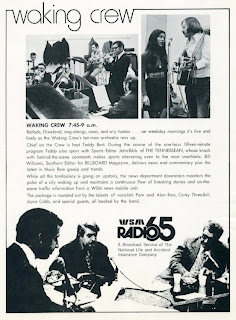The broadcast day started with John McDonald and the farm report. He was so popular as a commercial spokesman that he charged sponsors on his show $3 for every time each spot aired.
Ted Johnson was the morning man, smooth and knowledgeable with a great radio voice. He later owned a television production studio, and was the national voice of Lenscrafters for years. Listen to an aircheck of Ted from 1976 here.
I believe WSM was the last station in the country to have a live band in the studio each morning. The band members would do the morning radio show, the midday TV show, then roll down the hill to the bars, where I got to know a lot of them.
 | ||
What can you say about Ralph Emery? A legend.
Teddy Bart started out as a piano player, but quickly became a radio star in the talk arena. He is still active today.
Pat Sajak started in radio as a comedy writer in Chicago. His afternoon radio show was in the same league as Dr. Don Rose, with many groan-inducing puns. Pat also was a live booth announcer for WSM TV, and a weekend weatherman. He left in 1975 to do the weather in Los Angeles, an experience I think Steve Martin used in L.A. Story.
Remember when radio stations had real news departments? WSM and WLAC were always locked in battle for ratings and news scoops.
Hairl Hensley knows more about country music than anyone. His mellow voice on the radio and as an announcer on the Grand Ole Opry was the touchstone for many listeners. You can't think about Martha White Flour without thinking of Hairl.
Cap'n Jim and Flight 65 had the most popular air traffic reports in town for many years. Jim eventually took his plane to San Diego, where he was equally popular. In each city he ran out of fuel in the air at least once, and glided down to safety in a field. Flight 65 was later manned by long time reporter and policeman Richard Thomas, who switched to a copter.
Tom Bryant was a true production master. He came up through ham radio, so he knew the technical end cold. He also had one of the best voices ever, in the "Voice of God" catagory. And he could make spots. He would always call my commercial sound studio and let me know when my azimuth was off on the tape dubs. Find out more about Tom on his website here.
Part 3 will be posted soon.

















































